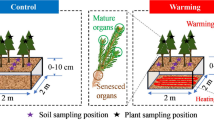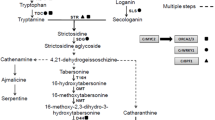Abstract
This study examined the effects of season-long exposure of Chinese pine (Pinus tabulaeformis) to elevated carbon dioxide (CO2) and/or ozone (O3) on indole-3-acetic acid (IAA) content, activities of IAA oxidase (IAAO) and peroxidase (POD) in needles. Trees grown in open-top chambers (OTC) were exposed to control (ambient O3, 55 nmol mol−1 + ambient CO2, 350 μmol mol−1, CK), elevated CO2 (ambient O3 + high CO2, 700 μmol mol−1, EC) and elevated O3 (high O3, 80 ± 8 nmol mol−1 + ambient CO2, EO) OTCs from 1 June to 30 September. Plants grown in elevated CO2 OTC had a growth increase of axial shoot and needle length, compared to control, by 20% and 10% respectively, while the growth in elevated O3 OTC was 43% and 7% less respectively, than control. An increase in IAA content and POD activity and decrease in IAAO activity were observed in trees exposed to elevated CO2 concentration compared with control. Elevated O3 decreased IAA content and had no significant effect on IAAO activity, but significantly increased POD activity. When trees pre-exposed to elevated CO2 were transferred to elevated O3 (EC–EO) or trees pre-exposed to elevated O3 were transferred to elevated CO2 (EO–EC), IAA content was lower while IAAO activity was higher than that transferred to CK (EC–CK or EO–CK), the change in IAA content was also related to IAAO activity. The results indicated that IAAO and POD activities in Chinese pine needles may be affected by the changes in the atmospheric environment, resulting in the change of IAA metabolism which in turn may cause changes in Chinese pine’s growth.



Similar content being viewed by others
References
Ashmore MR (2005) Assessing the future global impacts of ozone on vegetation. Plant Cell Environ 28:949–964
Bao F, Hu YX, Li JY (2001) Identification of auxin responsive genes in Arabidopsis by cDNA array. Chin Sci Bull 46:1988–1992
Basra AS (1994) Stress-induced gene expression in plants. Harwood Academic Publishers, Chur, Switzerland
Brenner ML, Cheikh N (1995) The role of hormones in photosynthate partitioning and seed filling. In: Davies PJ (ed) Plant hormones: physiology, biochemistry and molecular biology. Kluwer Academic Publishers, Dordrecht, pp 649–670
Cleland RE (1995) Auxin and cell elongation. In: Davies PJ (ed) Plant hormones. Kluwer Academic Publishers, Netherlands, pp 214–227
Davies PJ (ed) (2004) Plant hormones. Biosynthesis, signal transduction, action. Kluwer Academic Publishers, pp 204–220
Dermody O, Long SP, DeLucia EH (2006) How does elevated CO2 or ozone affect the leaf-area index of soybean when applied independently? New Phytol 169:145–155
Dickson RE, Coleman MD, Pechter P et al (2001) Growth and crown architecture of two aspen genotypes exposed to interacting ozone and carbon dioxide. Environ Pollut 115:319–334
Estes BL, Enebak SA, Chappalka AH (2004) Loblolly pine seedling growth after inoculation with plant growth-promoting rhizobacteria and ozone exposure. Can J For Res 34:1410–1416
Fuhrer J (2003) Agroecosystem responses to combinations of elevated CO2, ozone, and global climate change. Agr Ecosyst Environ 97:1–20
Gaspar T, Kevers C, Hausman JF et al (1992) Practical uses of peroxidase activity as a predictive marker of rooting performance of micropropagated shoots. Agronomie 12:757–765
Gaucher C, Costanzo N, Afif D et al (2003) The impact of elevated ozone and carbon dioxide on young Acer saccharum seedlings. Physiol Plant 117:392–402
Hausman JF (1993) Changes in peroxidase activity, auxin level and ethylene production during root formation by poplar shoots raised in vitro. Plant Growth Regul 13:263–268
Hiraga S, Sasaki K, Ito H et al (2001) A large family of class III plant peroxidases. Plant Cell Physiol 42:462–468
IPCC (2001) Climate change 2001. The Scientific Basis: URL: http://www.ipcc.ch/pub/tar/wg1/, Impacts, adaptation and vulnerability: URL:http://www.ipcc.ch/pub/tar/wg2/
Isebrands JG, McDonald EP, Kruger E et al (2001) Growth responses of Populus tremuloides clones to interacting carbon dioxide and tropospheric ozone. Environ Pollut 115:359–371
Karnosky DF, Pregitzer KS, Zak DR et al (2005) Scaling ozone responses of forest trees to the ecosystem level in a changing climate. Plant Cell Environ 28:965–981
King JS, Pregitzer KS, Zak DR et al (2001) Fine root biomass and fluxes of soil carbon in young stands of paper birch and trembling aspen as affected by elevated atmospheric CO2 and tropospheric O3. Oecologia 128:237–250
Kirschbaum MU (2000) Forest growth and species distribution in a changing climate. Tree Physiol 20:309–322
Lagrimini LM, Gingas F, Finger F et al (1997) Characterization of antisense transformed plants deficient in the tobacco anionic peroxidase. Plant Physiol 114:1187–1196
Law DM, Davies PJ (1990) Comparative indole-3-acetic acid levels in the slender pea and other pea phenotypes. Plant Physiol 93:1539–1543
Li CR, Gan LJ, Xia K et al (2002) Responses of carboxylating enzymes, sucrose metabolizing enzymes and plant hormones in a tropical epiphytic CAM orchid to CO2 enrichment. Plant Cell Environ 25:369–377
Long SP, Ainsworth EA, Rogers A et al (2004) Rising atmospheric carbon dioxide: plants FACE the future. Annu Rev Plant Biol 55:591–628
McDonald EP, Kruger EL, Riemenschneider DE et al (2002) Competitive status influences tree growth responses to elevated CO2 and O3 in aggrading aspen stands. Funct Ecol 16:792–801
McKay MJ, Ross JJ, Lowrence NL et al (1994) Control of internode length in Pisum sativum. Further evidence for the involvement of indole-3-acetic acid. Plant Physiol 106:1521–1526
Mohamed-Yasseen Y, Splittstoesser WE (1990) The relationship of several enzymes with IAA and phenols on flower induction in endive. Plant Growth Regul 18:133–139
Noormets A, McDonald EP, Kruger EL et al (2001) The effect of elevated carbon dioxide and ozone on leaf and branch-level photosynthesis and potential plant-level carbon gain in aspen. Trees 15:262–270
Normanly J, Slovin JP, Cohen JD (1995) Rethinking auxin biosynthesis and metabolism. Plant Physiol 107:323–329
Pritchard SG, Roger HH, Prior SA et al (1999) Elevated CO2 and plant structure: a review. Global Change Biol 5:807–837
Rao MV, Hale BA, Ormord DP (1995) Amelioration of ozone-induced oxidative damage in wheat plants grown under high carbon dioxide. Plant Physiol 109:421–432
Ros Barceló A, Mu OR (1992) Peroxidases: their role in the control of plant cell growth. In: Penel C, Gaspar TH, Greppin H (eds) Plant peroxidases 1980–1990.Topics and detailed literature on molecular, biochemical, and physiological aspects. University of Geneva, pp 71–89
Scalet M, Federico R, Angelini R (1991) Time courses of diamine oxidase and peroxidase activities, and polyamine changes after mechanical injury of chick-pea seedlings. J Plant Physiol 137:571–575
Schwanz P, Picon C, Vivin P et al (1996) Response of antioxidative systems to drought stress in pendunculate oak and maritime pine as modulated by elevated CO2. Plant Physiol 110:393–402
Taiz L, Zeiger E (2002) Plant physiology. 3rd edn. Sinauer Associates, Inc., Publishers
Taylor G, Tricher PJ, Zhang FZ et al (2003) Spatial and temporal effects of free-air CO2 enrichment (POPFACE) on leaf growth, cell expansion, and cell production in a closed canopy of poplar. Plant Physiol 131:177–185
Taylor JG (1997) Root hormones and plant growth. Annu Rev Plant Physiol 27:435–459
Teng NJ, Wang J, Chen T et al (2006) Elevated CO2 induces physiological, biochemical and structural changes in leaves of Arabidopsis thaliana. New Phytol 172:92–103
Usuda H (2006) Effects of elevated CO2 on the capacity for photosynthesis of a single leaf and a whole plant, and on growth in a radish. Plant Cell Physiol 47(2):262–269
Van Huystee RB (1987) Some molecular aspects of plant peroxidase biosynthetic studies. Ann Rev Plant Physiol 38:205–219
Vingarzan R (2004) A review of surface ozone background levels and trends. Atmos Environ 38:3431–3442
Wustman BA, Oksanen E, Karnosky DF et al (2001) Effects of elevated CO2 and O3 on aspen clones varying in O3 sensitivity: can CO2 ameliorate the harmful effects of O3? Environ Pollut 115:473–481
Yang J, Zhang J, Wang Z et al (2001) Hormonal changes in the grains of rice subjected to water stress during grain filling. Plant Physiol 127:315–323
Yong JWH, Wong SC, Letham DS et al (2000) Effects of elevated [CO2] and nitrogen nutrition on cytokinins in the xylem sap and leaves of cotton. Plant Physiol 124:767–780
Acknowledgements
This work was supported by the National Natural Science Foundation of China (90411019). The authors wish to thank Prof. Tao for his help in revision of the manuscript.
Author information
Authors and Affiliations
Corresponding author
Additional information
An erratum to this article can be found at http://dx.doi.org/10.1007/s10725-007-9214-y
Rights and permissions
About this article
Cite this article
Li, XM., He, XY., Chen, W. et al. Effects of elevated CO2 and/or O3 on hormone IAA in needles of Chinese pine. Plant Growth Regul 53, 25–31 (2007). https://doi.org/10.1007/s10725-007-9200-4
Received:
Accepted:
Published:
Issue Date:
DOI: https://doi.org/10.1007/s10725-007-9200-4




